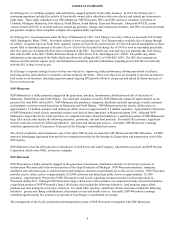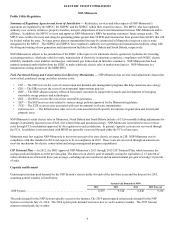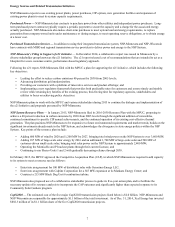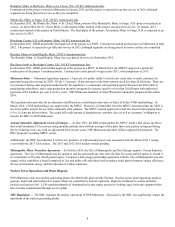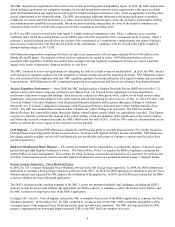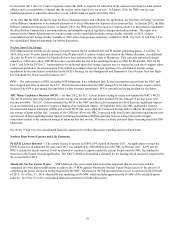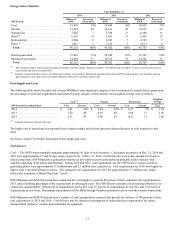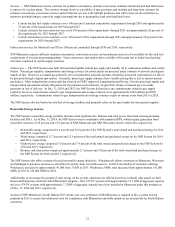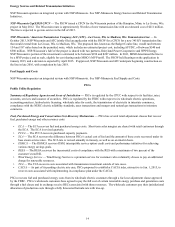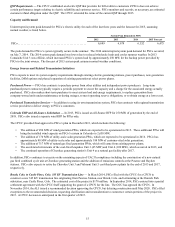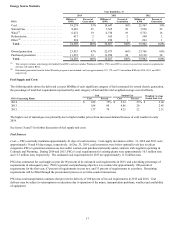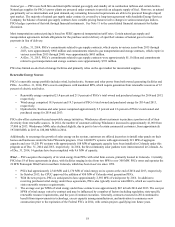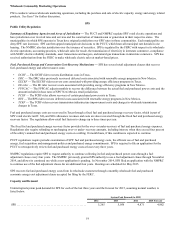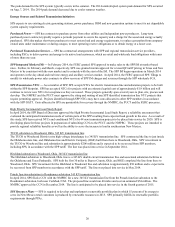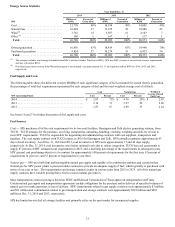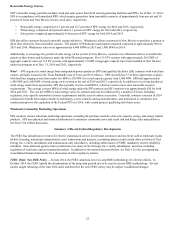Xcel Energy 2014 Annual Report Download - page 30
Download and view the complete annual report
Please find page 30 of the 2014 Xcel Energy annual report below. You can navigate through the pages in the report by either clicking on the pages listed below, or by using the keyword search tool below to find specific information within the annual report.12
Nuclear — NSP-Minnesota secures contracts for uranium concentrates, uranium conversion, uranium enrichment and fuel fabrication
to operate its’ nuclear plants. The contract strategy involves a portfolio of spot purchases and medium and long-term contracts for
uranium concentrates, conversion services and enrichment services with multiple producers and with a focus on diversification to
minimize potential impacts caused by supply interruptions due to geographical and world political issues.
• Current nuclear fuel supply contracts cover 100 percent of uranium concentrates requirements through 2018 and approximately
72 percent of the requirements for 2019 through 2027.
• Current contracts for conversion services cover 100 percent of the requirements through 2021 and approximately 62 percent of
the requirements for 2022 through 2027.
• Current enrichment service contracts cover 100 percent of the requirements through 2021 and approximately 68 percent of the
requirements for 2025 through 2027.
Fabrication services for Monticello and PI are 100 percent committed through 2030 and 2019, respectively.
NSP-Minnesota expects sufficient uranium concentrates, conversion services and enrichment services to be available for the total fuel
requirements of its nuclear generating plants. Some exposure to spot market price volatility will remain due to index-based pricing
structures contained in certain supply contracts.
Natural gas — The NSP System uses both firm and interruptible natural gas supply and standby oil in combustion turbines and certain
boilers. Natural gas supplies, transportation and storage services for power plants are procured under contracts to provide an adequate
supply of fuel. However, as natural gas primarily serves intermediate and peak demand, remaining forecasted requirements are able to
be procured through a liquid spot market. Generally, natural gas supply contracts have variable pricing that is tied to various natural
gas indices. Most transportation contract pricing is based on FERC approved transportation tariff rates. Certain natural gas supply and
transportation agreements include obligations for the purchase and/or delivery of specified volumes of natural gas or to make
payments in lieu of delivery. At Dec. 31, 2014 and 2013, the NSP System did not have any commitments related to gas supply
contracts; however commitments related to gas transportation and storage contracts were approximately $349 million and $389
million, respectively. Commitments related to gas transportation and storage contracts expire in various years from 2015 to 2028.
The NSP System also has limited on-site fuel oil storage facilities and primarily relies on the spot market for incremental supplies.
Renewable Energy Sources
The NSP System’s renewable energy portfolio includes wind, hydroelectric, biomass and solar power from both owned generating
facilities and PPAs. As of Dec. 31, 2014, the NSP System was in compliance with mandated RPS, which require generation from
renewable resources of 18 percent and 12.9 percent of NSP-Minnesota and NSP-Wisconsin electric retail sales, respectively.
• Renewable energy comprised 24.2 percent and 22.9 percent of the NSP System’s total owned and purchased energy for 2014
and 2013, respectively.
• Wind energy comprised 13.7 percent and 12.6 percent of the total owned and purchased energy on the NSP System for 2014
and 2013, respectively.
• Hydroelectric energy comprised 7.8 percent and 7.4 percent of the total owned and purchased energy on the NSP System for
2014 and 2013, respectively.
• Biomass and solar power comprised approximately 2.7 percent and 3.0 percent of the total owned and purchased energy on
the NSP System for 2014 and 2013, respectively.
The NSP System also offers customer-focused renewable energy initiatives. Windsource® allows customers in Minnesota, Wisconsin,
and Michigan to purchase a portion or all of their electricity from renewable sources. In 2014, the number of customers utilizing
Windsource increased to approximately 43,000 from 37,000 in 2013. Windsource MWh sales increased from approximately 181,000
MWh in 2013 to 186,000 MWh in 2014.
Additionally, to encourage the growth of solar energy on the system, customers are offered incentives to install solar panels on their
homes and businesses under the Solar*Rewards® program. Over 915 PV systems with approximately 11.1 MW of aggregate capacity
and over 679 PV systems with approximately 7.3 MW of aggregate capacity have been installed in Minnesota under this program as
of Dec. 31, 2014 and 2013, respectively.
As part of NSP-Minnesota’s North Dakota 2013 electric rate case settlement, NSP-Minnesota is required to file a system restack
proposal in 2015 to ensure that additional costs for compliance with Minnesota renewable initiatives are not paid for by North Dakota
customers.




